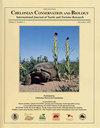Factors Affecting Nesting Times in the Painted Turtle Chrysemys picta in Nebraska
IF 0.8
4区 生物学
Q3 ZOOLOGY
引用次数: 9
Abstract
Abstract Although general descriptions of nesting in painted turtles (Chrysemys picta) are numerous, few studies have quantified the timing of the components of the nesting process, and no previous study has analyzed the factors influencing those times. The present study was conducted on the Crescent Lake National Wildlife Refuge in Garden County, Nebraska, in June 2012 and 2013 and focused on a single nesting population of female C. picta. We recorded times for the initiation of the nest foray, and the beginning and conclusion of nesting, and calculated search and construction times. Although highly variable, on average females left the marsh at 1709 hrs (n = 130), began nesting at 1745 hrs (n = 141), and finished nesting at 1915 hrs (n = 135). Search time averaged 26 min (n = 79) and nest construction time averaged 97 min (n = 104). We investigated the effects of female body size, air temperature, time of day, nest day, clutch number, substrate type, and reproductive output on these times. Smaller females nested earlier in the day, construction times were shorter in warmer temperatures, nests begun earlier in the day were completed more quickly, and nest times were longer earlier in the season and for first vs. second clutches. Soil type and measures of reproductive output had no effects on nesting times. These results suggest that temperature is a primary driver of nesting times, as these turtles exploit the afternoon–evening window of optimal temperatures, avoiding heat stress earlier in the afternoon and much colder evening temperatures as well as a presumed increase in predation risk after dark.影响内布拉斯加彩龟产卵时间的因素
尽管对彩龟筑巢的一般描述很多,但很少有研究量化了筑巢过程中各个组成部分的时间,而且之前也没有研究分析过影响这些时间的因素。本研究于2012年6月和2013年6月在美国内布拉斯加州加登县新月湖国家野生动物保护区进行,研究对象为单巢雌picta。我们记录了开始筑巢的时间,以及筑巢开始和结束的时间,并计算了搜索和建造的时间。虽然变化很大,但雌性平均在1709小时(n = 130)离开沼泽,1745小时(n = 141)开始筑巢,1915小时(n = 135)完成筑巢。平均搜索时间26 min (n = 79),平均筑巢时间97 min (n = 104)。我们研究了雌性体型、气温、一天中的时间、筑巢日、产卵数、基质类型和繁殖量对这些时间的影响。体型较小的雌鸟筑巢时间较早,在温暖的温度下筑巢时间较短,筑巢时间较早,筑巢时间较长,筑巢时间较早,第一次与第二次产卵的时间较早。土壤类型和繁殖产量对筑巢时间没有影响。这些结果表明,温度是筑巢时间的主要驱动因素,因为这些海龟利用下午到晚上的最佳温度窗口,避免了下午早些时候的热应激和晚上更冷的温度,以及天黑后可能增加的捕食风险。
本文章由计算机程序翻译,如有差异,请以英文原文为准。
求助全文
约1分钟内获得全文
求助全文
来源期刊
CiteScore
1.70
自引率
14.30%
发文量
17
审稿时长
>12 weeks
期刊介绍:
Chelonian Conservation and Biology is a biannual peer-reviewed journal of cosmopolitan and broad-based coverage of all aspects of conservation and biology of all chelonians, including freshwater turtles, marine turtles, and tortoises. Manuscripts may cover any aspects of turtle and tortoise research, with a preference for conservation or biology. Manuscripts dealing with conservation biology, systematic relationships, chelonian diversity, geographic distribution, natural history, ecology, reproduction, morphology and natural variation, population status, husbandry, community conservation initiatives, and human exploitation or conservation management issues are of special interest.

 求助内容:
求助内容: 应助结果提醒方式:
应助结果提醒方式:


